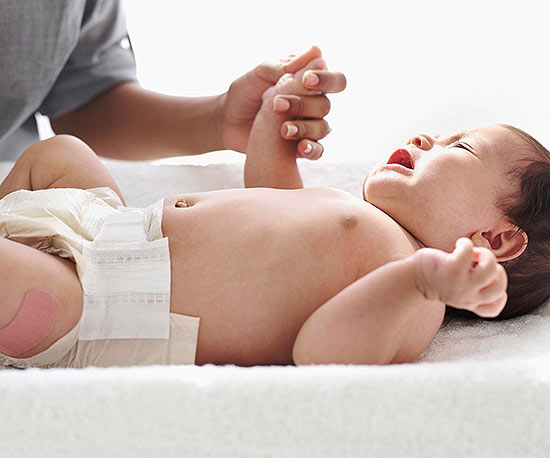
Being a parent requires getting down and dirty: There are orifices to probe, secretions to suction, and always that nagging suspicion that your technique is wrong. Fortunately, babies are hardier than their fragile appearance suggests. "An infant may cry and not like certain things you do to ensure her well-being, but the odds of hurting her while you're providing tender loving care are pretty slim," says Daniel Nicklas, M.D., a pediatrician at Children's Hospital Colorado, in Aurora. Nonetheless, if the thought of tackling certain baby duties makes you freak out, we'll teach you how to handle even the most unnerving ones.
Caring for the Umbilical Cord
A baby's belly button is adorable — when it's healed. Until then, that shriveled and blackened stump looks rather shocking against your newborn's perfect skin. You may be worried about tearing off the stub prematurely during diaper changes or sponge baths. And until it scabs over, there's always a risk of infection.
Master the task: Your mom probably dabbed your cord stump with rubbing alcohol, but research now shows that this does little to prevent infection and it might even extend the time it takes for the cord to fall off. Today, doctors recommend using a washcloth moistened with plain water to clean around the sides of the stump, as well as the skin surrounding it, once a day or as needed with diaper changes. Gently pat dry the area with a soft cloth and fold your baby's diaper below the navel to keep the area dry. It can take anywhere from two to eight weeks for the stump to fall off. Until then, give your baby sponge baths. Don't panic if you accidentally tear off the stubby part sooner. "There may be a little bleeding because the nub can act as a scab. However, the navel should still heal normally," says pediatrician Laura Jana, M.D., coauthor of Heading Home With Your Newborn. Call your doctor if you notice continued bleeding or signs of infection such as yellow pus, a foul-smelling discharge, redness, or swelling. And never apply medicated ointment to the area without first getting your doctor's okay.
Extracting Mucus
Your baby can't blow his own nose, so it's your job to suction out snot when he's stuffy. And since his nostrils are tiny, you may feel anxious about inserting a bulb syringe too far and potentially harming his nasal passages.
Master the task: To keep your squirming baby as still as possible, swaddle him in a blanket with his arms at his sides. Then squirt a few drops of saline solution into each nostril to loosen and thin out mucus. (You can make your own by dissolving 1/4 teaspoon of salt in 8 ounces of lukewarm purified water, or use an over-the-counter saline spray.) To draw out the mucus, squeeze the bulb, gently insert the tip into a nostril, and then release the bulb. Remove the syringe from your baby's nostril, and deposit the secretions onto a tissue. It's very unlikely that you'll insert the tip too far. In fact, Dr. Jana says the real hazard is overuse. "Suctioning can irritate the lining of the nose and cause soreness and or bleeding," she warns, so only clear your baby's mucus if it seems to be bothering him.
Using a Rectal Thermometer
This kind provides the most accurate reading for babies. You want to put it in far enough for a good reading but not so far that you may cause discomfort.
Master the task: Many thermometers have a silver tip that's about half an inch long. This tip is about as far as you want to go for a baby age 3 months or younger, says Dr. Nicklas. To get the best view, place your child on her back on a changing table or the floor. Bend both of her legs to her chest, placing a hand against the back of her thighs to keep them up. With your other hand, slide the tip of the thermometer (already lubricated with petroleum jelly) into her anus. Hold the thermometer in place for about one minute or until you hear a beep. Remove it and check the reading. This process can stimulate a bowel movement, so keep wipes nearby.
Cleaning Genitals
Each sex has its own unique cleaning and diapering challenges. "Newborn girls sometimes have a mucusy, bloody vaginal discharge for a few days after birth while estrogen from the mother leaves their body," explains Dr. Jana. Plus, girls have a lot of skin folds that require cleaning. A circumcised boy requires special care for about a week until his penis is healed.
Master the task: Always wipe from front to back on both girls and boys to prevent the spread of fecal matter into the urethra where it can potentially cause a urinary tract infection. For circumcised boys, gently wipe the tip of the penis clean with warm water on a clean cloth after each diaper change and then dab petroleum jelly on and around the head of the penis to keep the circumcised area from sticking to the diaper as it heals. It's normal for him to have a yellowish scab during this healing time; however, call your doctor if you notice signs of infection such as swelling, redness that lasts more than a week, or pus-filled blisters. If your son isn't circumcised, clean the penis as you would any other part of his body with a gentle baby soap and water during his bath, and simply wipe the area during diaper changes. But don't force back the foreskin, says Dr. Jana; it may cause irritation.
Cutting Nails
A baby's fingernails grow super-fast, so you may need to trim them more than once a week. Unfortunately, when snipping tiny nails, there's always the possibility that you'll accidentally catch a piece of skin along with the nail.
Master the task: Use baby-size nail scissors or clippers and trim your baby's nails while she is sleeping and her hands and arms aren't flailing around. To avoid accidentally drawing blood, push down on the fingertip skin to pull it away from the nail as you cut. If your infant's skin gets nicked (and it will happen), gently apply pressure with a sterile gauze pad or tissue until the bleeding stops. Don't put a bandage on the cut, though, cautions Dr. Nicklas. "Babies constantly suck on their fingers, and they can choke if a bandage comes off in their mouth." If you'd rather not cut your baby's fingernails at all, you can simply file them down with an emery board, says Dr. Nicklas.
Originally published in the November 2014 issue of Parents magazine.
All content on this Web site, including medical opinion and any other health-related information, is for informational purposes only and should not be considered to be a specific diagnosis or treatment plan for any individual situation. Use of this site and the information contained herein does not create a doctor-patient relationship. Always seek the direct advice of your own doctor in connection with any questions or issues you may have regarding your own health or the health of others.
Parents Magazine

